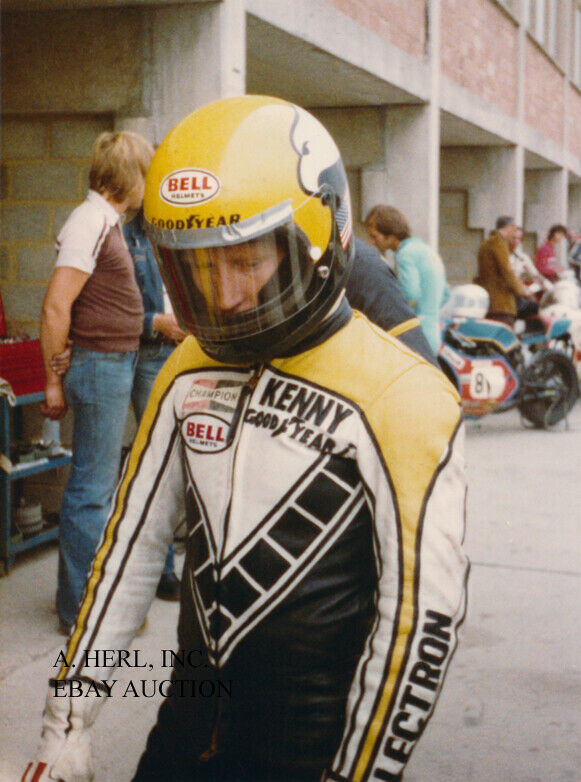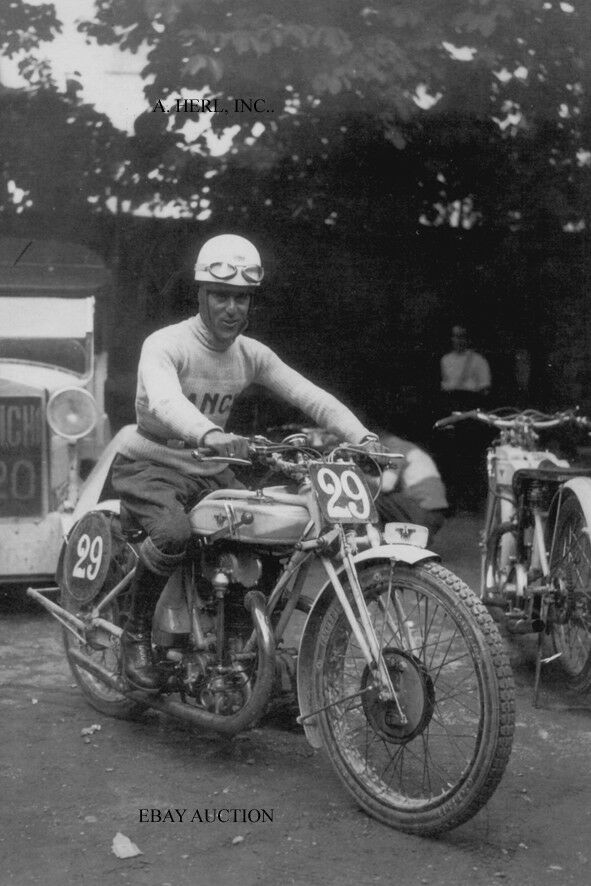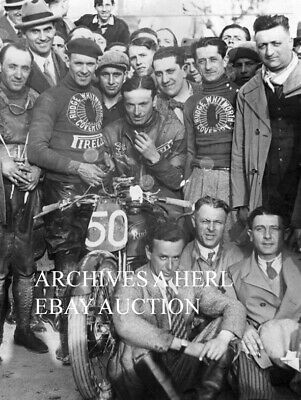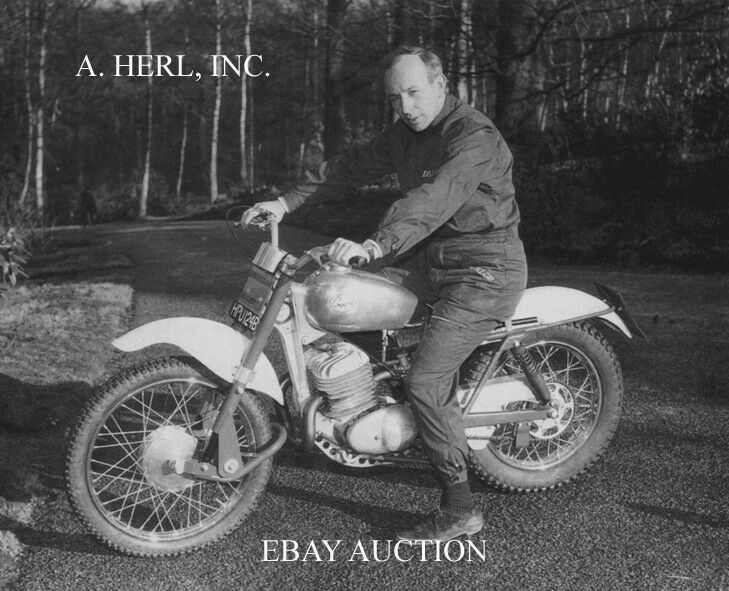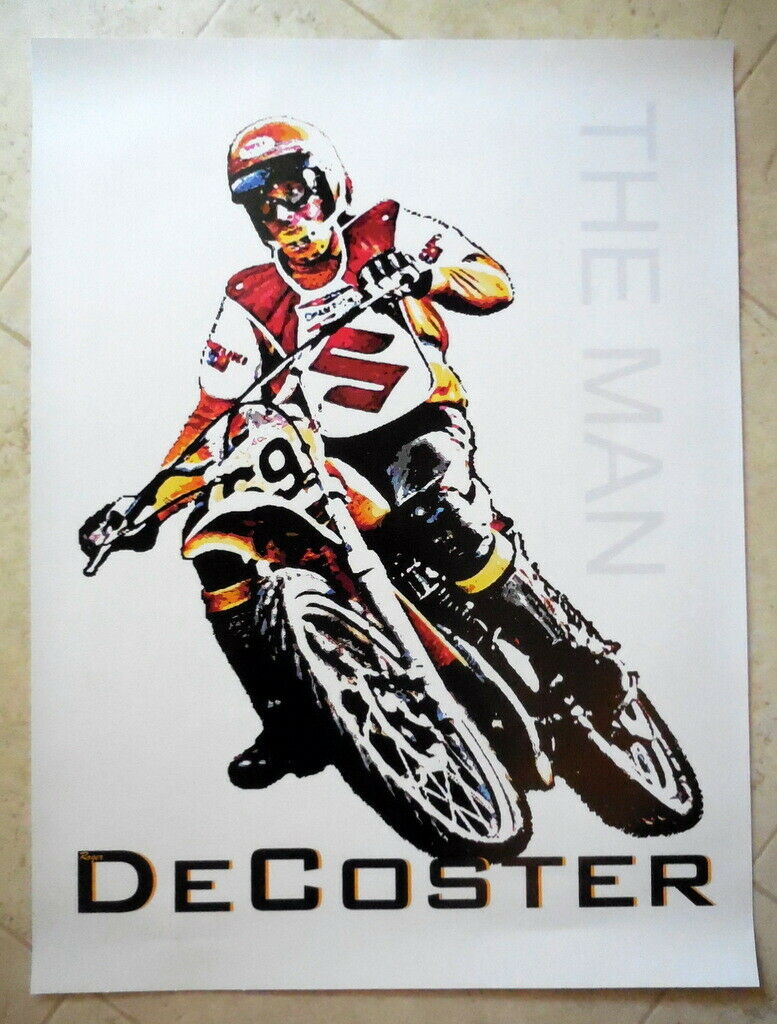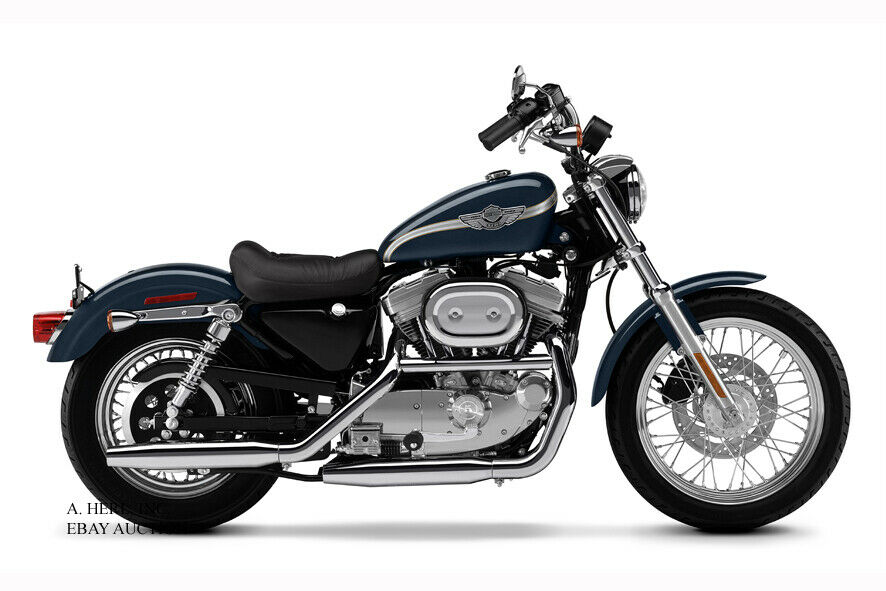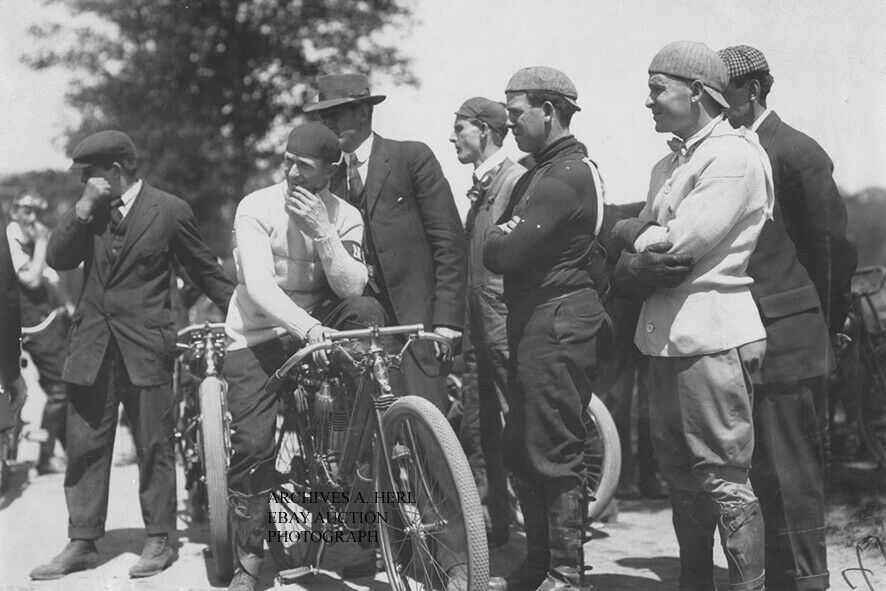-40%
Indian 8 valve 61ci V-twin 1912 & John Constant– Chicago board track 1912 photo
$ 5.14
- Description
- Size Guide
Description
A superb and extremely rare image showingJohn Constant
and his amazing
1912 Indian 8-valve 61 c.i. (1,000cc) V-twin factory racer
, photographed in
1912
at the wooden
Riverview Boardtrack
in
Chicago
,
Ill
,
USA
.
Board track racing was as popular as it was dangerous in the 1910s and 1920s.
Basically racing was done on a wooden, banked oval that was made up of two by fours.
The rough wooden surface was often heavily splintered due to the unleash of raw motorcycle power on the soft, easy to deteriorate, wood.
Not only that, but the bikes normally had a total-loss oiling system.
After its lubrication duty, the oil simply seeped out of the engine on the wooden track, making it besides splintery also very slippery.
Combine this with the fact that the riders did not have the protective clothing as they have now and mix in the speeds that easily exceeded
100 mph
and you will understand that board track races were greeted with great excitement, fear, and anxiousness by both the public as the riders.
Clearly the board tracks were not the most ideal venues for racing, but in an era where spectator orientated bicycle racing domes initially were also considered ideal for motorized bicycle racing, it was hard to change locations.
Board track racing was a true American specialty, though in other parts of the world it was done as well, though these tracks were often much shorter.
The men that raced on these early tracks were specialists that rode on the limit of what the motorcycle could possibly offer, despite all the dangers.
No wonder that these men grew out to symbols of pure motorcycling heroism! Excelsior, Indian, Harley-Davidson and Reading-Standard all did their best to obtain the highest result possible.
This wonderful photo reflects that golden era of board track racing with all its great and interesting machines.
Exciting times!
The absolutely magnificent
Indian 8-valve (!!!) 61 c.i. (1,000cc) V-twin racer
has a very interesting history that went straight back to the wooden board tracks that ruled racing in the beginning of the 20TH century.
Bicycle racing on banked, wooden velodromes was enormously popular at the turn of the 20th century. Many of the very first machines identifiable as motorcycles were built by bicycle mechanics, and were used as "pacers" to train bicycle racers. The first race probably occurred the first time that two of them happened to be on the track at the same time. Oscar Hedstrom was one of these enterprising young mechanics, and his design was so elegant and reliable that it was produced in quantity by the Hendee Manufacturing Company as the first Indian motorcycle. Timber was cheap, labor was plentiful, and board track racing offered a level of spectacle not seen since Roman times. With the help of an engineer from
New Jersey
by the name of Jack Prince -- who sought to build a chain of large tracks from coast to coast -- board track races spread across the nation like wildfire. The Coliseum in Los Angeles, over a quarter mile long, was opened in 1909, followed immediately by a one-third mile bowl in Springfield, Mass., and in 1910 by full mile-long tracks in Playa del Rey, California (a suburb wedged between Los Angeles and the Pacific ocean) and Salt Lake City, Utah. Tracks up to two miles in length were thrown up in
1911 in
Oakland
,
Denver
,
Buffalo
,
Cleveland
,
Chicago
, and
Detroit
. 1912 brought tracks to
Milwaukee
,
Omaha
,
Houston
,
Cleveland
and
Atlantic City
. Race promoters made wads of money, with ,000 daily gate receipts a common draw. Very high speeds and a complete lack of safety precautions lead to spectacular wrecks on the board tracks in the 1910s, often killing a half-dozen competitors and spectators at a time. Controversy over safety had already caused the national sanctioning organization to switch the 1913 National Championship Races over from the boards to the safer, but less profitable, dirt ovals. True to form, racing improved the breed. Motorcycles went from able-to-keep-up-with-bicycles in 1900 to the first 100-mph average lap, turned by Lee Humiston on a "Big-Valve" Excelsior at the Playa del Rey track in 1912. Technical competition among the manufacturers was just as fierce as the racing itself. The race for prestige led famous manufacturers like Indian, Excelsior, Cyclone, Thor, and Flying Merkel to develop purpose-built racing equipment with the highest attainable horsepower they could squeeze from their motors. However, none of these machines was as impressive as the
Indian 61 c.i. 8-valve V-twin racer
. It was introduced in 1911 and was produced until 1918. Indian placed it on sale to the public at the astronomical price of 0. It featured overhead-valve heads with four valves per cylinder, and was easily capable of speeds of over
120 mph
. In various forms, it was raced on the dirt track as well as on the boards with very great success. It is unknown how many of the 8-valve racers were manufactured, but production was very small indeed; most machines were ridden either by factory riders or were "loaned" to promising privateers. Like the other board track bikes of its era, it lacks such amenities as brakes, a clutch, or even a throttle (carbs were run wide open, with the only control of the engine speed being an ignition cut-out).
This wonderful photo reflects that golden era of board track racing as no other.
How exciting where those times!
We have more photos, also listed on Ebay, of other bikes, and various motorcycle (world) champions on various kinds of machinery. Please check out our auctions and take advantage of our shipping discount! The auction selection is refreshed and changed continuously.
This is your rare chance to own this non period photo that reflects a very interesting and historic piece of motorcycle history. Therefore it is printed in a nice large format of ca. 8" x 10" (ca. 20 x
25 cm
).
Check out our auctions or contact us for more motorcycle (racing) photos!
Check out our other Ebay auctions or contact us for more motorcycle and car (racing) photos! Combine our auctions and save on shipping.
Shipping costs will only be $ 7.00 regardless of how many photos you buy. For 5 or more photos, shipping is free!
(Note: A. Herl, Inc. does not appear on photo, for ebay purposes only)
No copyright expressed or implied. Sold as collectable item only. We are clearing out our archives that we have gathered from various sources.
All items always sent well protected in PVC clear files
and board backed envelopes.
We have photographs that came from professional collections and/or were bought from the original photographer or press studio! They are all of professional and excellent quality.
After many decades of professionally collecting photographs and posters we are clearing out our archives. They make the perfect gift and are perfectly suited for framing. They will look gorgeous unframed and will be a true asset nicely framed with a border. They are a gorgeous and great asset in every home, workshop, workplace, restaurant, bar or club!
First come - first served. And you can always contact us for your requests. Please ask any questions before the auction ends.

